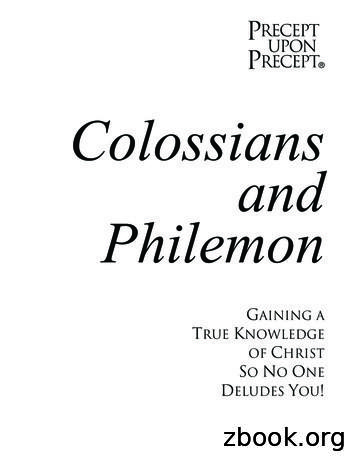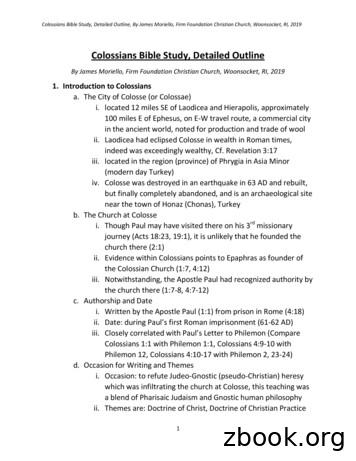Colossians Intro Notes - Chcsmallgroups.files.wordpress
ColossiansIntroductory NotesPrison EpistleColossians was written by the apostle Paul from prison in Rome and is known as a prison epistle,along with Ephesians, Philippians, and Philemon.Paul’s arrest was, basically, a kind of house arrest where visitors could come and visit Paul, buthe was in Rome under house arrest there (Platt).Prison epistle relationships:Colossians and Philemon both sent to Colossae.Colossians and Ephesians both carried by Tychicus.Ephesians reflects theological development of Colossians.All were probably written not long after Paul arrived in Rome. Philippians was likely last sincePaul expected to be released soon (Easley 313).EpistleAn epistle is a pastoral letter, driven by occasion and by the need of its recipients.Standard parts of an epistle: salutation, thanksgiving, main body, farewell (Easley 314).Sometimes, the thanksgiving section was omitted. (Ex.: 2 Corinthians)Colossians follows Paul’s classic pattern: first two chapters doctrinal (Christ as head of thechurch), last two practical (holy Christian living). Written by Paul with secretarial help fromTimothy. Delivered by Tychicus. (Easley 312-4)Paul was very cautious in his letters to not to put practical application ahead of the gospel. Wemust look back at practical application through the lens of the gospel. (Shaddix)RecipientsLike all New Testament letters written by Paul, Colossians is titled according to first recipients,Christians in Colossae (Easley 309). Colossae is located in modern-day Turkey, approximately120 miles from Ephesus.Mixed Jewish and Gentile believers in Colossian church because of syncretistic beliefscombining Jewish and Greek elements (Easley 312).
City of Colossae – in the valley of the Lycus River in a mountainous district about 100 miles eastof Ephesus. Overshadowed in importance by neighboring cities Laodicea and Hierapolis(Gundry plications that Paul neither founded nor visited the church in Colossae: Paul had “heard” of their faith (1:4). Epaphrus must have founded it (1:7). Epaphras was likely a convert through Paul (1:6-7) and was with Paul at the time ofwriting this letter (4:12-13). Paul was a “grandfather” to this predominantly Gentile church (Gundry 394).
PurposePaul’s warning to the church at Colossae was to be faithful to what started their church (“whatyou have heard”) (Shaddix).The Colossians were under the spell of a syncretistic blend of Jewish and Hellenistic elementswhich Paul recognized as a serious threat to the survival of true Christianity (Easley 314).Basically, Paul was encountering Gnostics in Colossae who were denying the deity of Christ.Gnostics believed that all matter is evil and that includes our humanity. So, if Christ was ahuman, then He couldn’t have been God and man at the same time. This line of thinkingquestions the Incarnation (Platt). It detracted from person of Christ, emphasized humanphilosophy, flaunted exclusivist air of secrecy and superiority. This syncretistic heresy blendedJewish legalism, Greek philosophic speculation, and Oriental mysticism. (Gundry 394-395).Dangerous teaching in Colossae known only through Paul’s letter. Colossians was the first letterwritten to stop false teachings (Easley, 310).ThemesThe divine person and creative and redemptive work of Christ against devaluation of Christ by aparticular brand of heresy that threatened the church in Colossae. Practical implications of thishigh Christology for everyday life and conduct. (Gundry 392).“Any salvation which is ‘Jesus plus’ is defective.” (Easley, 310)Key words: firstborn, fullness, freedom (Easley, 314).Key VerseColossians 1:18Key Term: “preeminence” (Easley, 309) HCSB: “first place”Christ in ColossiansPaul lauds Christ through these statements: His kingdom (1:13) His redemptive work (1:14) His being the outward representation (“image”) of God in human form (1:15) His supremacy over creation as its master and heir (since firstborn sons received moreinheritance than other sons, “first-born of all creation” (1:15) need not imply thatJesus was the first to be created His creatorship (1:16) His pre-existence and cohesion of the universe His headship over the new creation, the church His primacy in rising from the dead never to die again (Gundry 396)
Christ in Colossians (cont.)“No Bible book more explicitly teaches that Jesus is fully God.” (Easley, 310)Christ in Colossians: “Christ is creator of all things, whether visible or invisible. He is the Onewho holds all creation together. The fullness of God lived in him and through Christ’s deathGod reconciled everything to himself.” (Easley, 311)“The primary theme is the sufficiency of Christ. Christ is all and in all . The supremacy ofChrist is all over the book of Colossians. Every major point deals with the sufficiency andsupremacy of Christ. I have listed . . . a portrait of Christ in Colossians. He is the Head of allthings, the Lord of creation, the Author of reconciliation, the basis for our hope, the basis for thesource of our power. He is our Redeemer and Reconciler. He is the embodiment of God, thefullness of the Godhead dwelled in Him. He is the Creator and Sustainer of all things, and the allsufficient Savior. It is an incredible picture of Christ” (Platt).Applying ColossiansAs you read, mark some of these key words and notice the practical implications of a life that issustained by Christ alone. It is not just showing the supremacy of Christ, it is showing how thataffects the way we live. Here’s the picture and the practical implication of Colossians for us:Multiply the gospel, as individuals and as churches. We will then have things going on aroundthe world that we don’t even know about because of the multiplication of the gospel. That is thepicture in Colossians (Platt).
Outline of ColossiansINTRODUCTION (1:1-12)A. Greeting (1:1-2)B. Thanksgiving (1:3-8)C. Prayer (1:9-12)I. THE PREEMINENCE OF CHRIST IN CHRISTIAN DOCTRINE (1:13-2:23)A. His creative and redemptive work (1:13-23)B. His proclamation by Paul (1:24-2:7)C. His sufficiency over against the Colossian heresy (2:8-23)II. THE PREEMINENCE OF CHRIST IN CHRISTIAN CONDUCT (3:1-4:6)A. Union with Christ in his death, resurrection, and exaltation (3:1-4)B. Application of death with Christ to sinful actions (3:5-11)C. Application of resurrection with Christ to righteous actions (3:12-4:6)CONCLUSIONA. The coming of Tychicus and Onesimus (4:7-9)B. Greetings and final instructions (4:10-17)C. Farewell and benediction (4:18)(Gundry 395)Sources:BiblePlaces.com. http://www.bibleplaces.com/colossae.htm.Easley, Kendall H. Holman Quick Source Guide to Understanding the Bible. Nashville:Holman Reference, 2002.Gundry, Robert H. A Survey of the New Testament. Grand Rapids, MI: Zondervan, 1994.Platt, David. Secret Church: Survey of the New Testament, Part 2. April 27, ilter series.Shaddix, Jim. Notes from message on Colossians 1:1-8. Supremacy of Christ Conference.February 28, 2011.
Colossians Introductory Notes Prison Epistle Colossians was written by the apostle Paul from prison in Rome and is known as a prison epistle, along with Ephesians, Philippians, and Philemon. Paul’s arrest was, basically, a kind of house arrest where visitors could come and visit Paul, but he was in Rome under house arrest there (Platt).
Colossians 1.7. AS YE HAVE LEARNED OF EPAPHRAS —“The Colossians had learned these Truths from Epaphras, whom Paul identifies as a fellow-slave with him in service to the Gospel. This preacher is also mentioned in Colossians 4.12 and Philemon 1.23. Paul mentioned in Colossians 2.1 that the Colossians and Laodiceans had not seen him personally.
Colossians from Rome. It is likely that Ephesians, Colossians and Philemon were written about the same time and were delivered by a man named Tychicus (Eph 6:21, Col 4:7). You will notice many similarities between Ephesians and Colossians. In Colossians Paul mentions the church in Lao
Colossians and Galatians is 'correction' of serious doctrinal deviation from the already-given standard."1 Stylistically, Colossians is somewhat tense and abrupt, whereas Ephesians is more diffuse and flowing. Colossians tends to be more specific, concrete, and elliptical—whi
The book of Colossians is characterized by repeated emphasis on positional truth (status quo of the believer in God's eyes) (1:24-29; 2:9; 2:20-3:4). F. The book is Christocentric (Christ-centered). Colossians 1 Colossians 1:1 "Paul, an apostle of Jesus Christ by the will of God, and Timothy our brother."
4. According to Colossians 1:6-8 and 4:12-13, who did the Colossians hear the gospel from? 5. Read Colossians 1:2 and 4:13-16. a. Where else was this letter to be read? b. Locate on the map the places named in these verses. As you read
Paul’s Letter to the Colossians Events Leading to the Writing of Paul’s Letter to the Colossians Written From Rome During Paul’s First Imprisonment, c. A.D. 62 The Epistle of Paul the Apostle to the COLOSSIANS INTRODUCTION 1 1. Title. Like Paul’s other epistles, this o
Colossians 1:1 with Philemon 1:1, Colossians 4:9-10 with Philemon 12, Colossians 4:10-17 with Philemon 2, 23-24) d. Occasion for Writing and Themes i. Occasion: to refute Judeo-Gnostic (pseudo-Christian) heresy which was infiltrating the church at Colosse, this teaching was a bl
work and language games. - reading texts extending the main story-line. - translation exercises. - some songs and poems for learners. At the end of the book you will find the texts of the listening exercises, a summary of the grammar covered in the course, a pronunciation guide and Russian to English and English to Russian dictionaries.






















